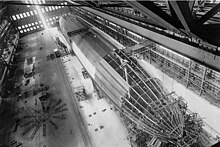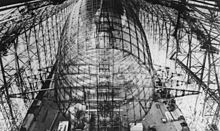Rigid airship
Rigid airships are airships with a complete skeleton of girders and struts. This framework defines the outer mostly aerodynamic shape of the hull.
In addition to the almost 120 zeppelins , around 50 rigid airships were also made by other manufacturers. Many of these airships crashed shortly after their maiden voyage. This led to airship travel being discontinued in the course of the 1930s, with Germany having the LZ 130, the last large rigid airship, in operation until 1939.
properties

The skeleton rings were mostly vertical and connected by longitudinal beams. In addition, the construction was braced with steel cables , which contributed to the dimensional stability with sufficient elasticity . The engines and driver's gondolas could simply be hung on the frame. Payload, ballast (mostly water) and operating materials (fuel and lubricating oil) could be stored optimally distributed and partially used for trimming . The stabilizing fins at the stern were integrated into the frame structure. The interior of the fuselage offered a lot of sheltered space for the crew, passengers and the payload. One advantage of the solid structure is that it maintains the shape of the airship and thus also the aerodynamic controllability in the event of gas loss.
In the case of a rigid airship, the framework ensures the shape, the outer skin the weather resistance and the gas cells the gas tightness. With the impact airship, these three tasks are taken over by the firm outer skin. Rigid airships can only be meaningfully constructed from a certain size, which clearly exceeds that of impact airships, due to the additional construction elements.
Inside rigid airships , the lift is generated by the lifting gas in gas cells which, unlike impact airships or semi-rigid airships, do not need to make any contribution to the shape of the ship.
The overpressure in the gas cells is lower than in airships : at the bottom zero and at the top specific load-bearing capacity (gas density difference times g ) times the height above the lower gas level. With a ship diameter of 40 m and a specific load capacity of 12 N / m³: 480 Pascal (Pa). As a result, gas is lost less quickly in the event of damage, and only the injured cell runs empty. In the case of the impact airship, the entire buoyancy body runs empty and it loses its shape. Ballonets are not required on the rigid airship.
Historic rigid airships
First prototype by David Schwarz
The first rigid airship was an all-metal airship developed by David Schwarz in 1895/1896 . The Schwarz family later moved to Agram (today's Zagreb in Croatia ), where David developed the prototype of the all-metal airship as an autodidact . It consisted of a lattice girder structure and was planked with aluminum sheet . In addition, the float was divided into 13 gas cells. The external shape was also new. It consisted of a lying cylinder with a cone on the bow . It was equipped with a gasoline engine that produced 12 hp at 480 revolutions per minute . The aluminum was supplied by the manufacturer Carl Berg , who was later to manufacture parts for the zeppelins from this very material. The airship was destroyed during its test run on November 3, 1897 on the Tempelhofer Feld in Berlin. This airship was the first application of the new material aluminum, shown for the first time at the Paris World Exhibition in 1889, in aviation.
Zeppelin (Germany)
Ferdinand Graf von Zeppelin , who completed his LZ 1 prototype in 1900, is considered an outstanding airship pioneer . Graf Zeppelin was also present when the Schwarz airship was in Berlin in 1897, but was not allowed to enter the airfield at the time. The scaffolding of LZ 1 was partly made from the remains of the Schwarz airship. His zeppelin airships play such a dominant role in the history of rigid airship travel that the term “zeppelin” is often used as a synonym for “rigid airship”.
Zeppelins were used for short-haul passenger journeys even before the First World War . The operator of the zeppelins, DELAG , founded in 1909 , was the first airline in the world. During the war, rigid airships were used on a large scale for reconnaissance and bombed air raids. They experienced their heyday as civil aircraft from the 1920s, when they were mature enough to also enable long-distance flights. While British and American rigid airships perished as early as 1930 due to serious accidents, the LZ 127 "Graf Zeppelin" and LZ 129 "Hindenburg" vehicles enabled the first regular non-stop passenger flight connection to the USA and Rio de Janeiro in the 1930s . The Hindenburg and its sister airship , the LZ 130 "Graf Zeppelin II", were the largest airships ever built with a volume of 200,000 m³, lengths of 245 m, diameters of over 41 m and a mass of over 240 tons. But the German airship industry of this era was not spared from serious accidents: On May 6, 1937, after crossing the Atlantic, the zeppelin "Hindenburg" caught fire over the airfield of Lakehurst / USA and was destroyed. This catastrophe, which claimed 36 lives, ushered in the decline of commercial airships; it was musically processed by the American composer Steve Reich in his composition "Three Tales". The outbreak of World War II in 1939 brought civil aviation to an abrupt end.
See also: List of Zeppelins and: Zeppelin military airships
Schütte-Lanz (Germany)
The Schütte-Lanz Rigid Airships were built exclusively for military purposes during the First World War and competed successfully with the zeppelins during this time without endangering their supremacy. They were up to 198 m long and measured up to 23 m in diameter with 56,000 m³ of lifting gas volume . Her skeleton was initially made of plywood . Important innovations in the construction of rigid airships came from Schütte-Lanz. Due to the First World War and due to demands from the military, these innovations also found their way into Zeppelin very quickly. Therefore, after the war, there were patent disputes between the two companies.
See also: List of Schütte-Lanz airships
Great Britain
The rigid airships of other nations are given little attention in view of Germany's prominent role in this area. Airship travel in Great Britain was an exception at times , where around 30 rigid airships were built and operated. Including the R34 , which was the first airship to cross the Atlantic in 1919 , and the two large airships R100 and R101 , which in their design anticipated many of the passenger comfort features of the German Zeppelin Hindenburg. However, after the tragic crash of the R101 airship in 1930, British rigid airships were abandoned.
See also: List of British Rigid Airships
France
Only one rigid airship was built in France . The Spiess was developed by the Alsatian Joseph Spieß based on the Zeppelin LZ 16 , built by Zodiac and was first promoted on April 13, 1913. In terms of technology, the prototype was particularly comparable to the Schütte-Lanz airships that existed to date. Two Chenu motors with around 200 hp each were used as drive . The scaffolding consisted of a wooden tube construction and had a diameter of 13.5 m. Despite subsequent improvements, in which it was extended from 104 to 146 m (the volume increased from 11,800 to 16,400 m³), it was able to meet the expectations of the French The military did not comply as speed, payload and stability did not seem sufficient enough. In 1914, the military had the airship dismantled accordingly.
United States

The USA also operated some rigid airships, some of which were, however, co-developed by the Zeppelin Society or were based on war zeppelins. A total of five rigid airships were built by or on behalf of the USA. They were all ordered by the U.S. Navy and were the only rigid airships that used helium as a lifting gas .
- ZR-1 " USS Shenandoah " was the first rigid airship ever to be filled with helium. Its maiden voyage took place on September 4, 1923.
- ZR-2 was built in England under the designation R38 , but was still filled with hydrogen and broke in the air before it was shipped to the USA.
- ZR-3 "USS Los Angeles" was the zeppelin with hull number LZ 126 . This airship was the only one of the US rigid airships that was not destroyed in an accident.
- ZRS-4 " USS Akron " and ZRS-5 "USS Macon" were able to deploy reconnaissance aircraft while they were in motion and recover them again. They served as flying aircraft carriers . The "USS Akron" made a ten-hour voyage on November 3, 1931 with 207 people on board. This represents a superlative to this day, as well as the end of the "USS Akron": with 74 deaths, it is the worst airship disaster to this day.
The all-metal airship ZMC-2 , which was operated from 1929 to 1941, had a frame-reinforced airship body formed from sheet aluminum. However, it was classified as an impact airship by the US Navy because it required a slight overpressure inside to maintain its shape.
Current rigid airship projects
There are currently no rigid airships.
In the 1990s, some airship projects with different rigid or semi-rigid constructions were presented, but have not yet been implemented. These include, for example:
- the "AVEA" project of the ETH Lausanne , which competed with the Cargolifter,
- the projects D-1 and D-4 of the US-American Eros Corporation ,
- the "Sky Station" project of the former US Secretary of State Alexander M. Haig Jr. , in which airships are used as unmanned telecommunications platforms in the stratosphere and should therefore compete with communications satellites .
- In 2005, the unmanned Sanswire Stratellite was used on a prototype for an unmanned high-flying solar rigid airship that is to be used for telecommunications tasks, and a hovering mock-up was produced. However, the project did not materialize.
Airships that exist today are either semi-rigid airships ( e.g. Zeppelin NT ) or unframed impact airships , so-called blimps. The Cargolifter project, which was discontinued in 2003, was a planned semi-rigid or keel airship .
literature
- Peter Kleinheins: The big zeppelins. The history of airship construction. 3. Edition. Springer, Berlin, Heidelberg, New York 2005, ISBN 3-540-21170-5 .
- Price Bradshaw: The role of technology in the failure of the rigid airship as an invention. Dissertation. University of Florida , 1975, OCLC 37414918 . (online at: archive.org )
Individual evidence
- ↑ http://www.airshipsonline.com/airships/r100/index.html accessed on December 29, 2016
- ↑ www.century-of-flight.net
- ↑ Helmut Braun: The rise and fall of airship travel - an economic historical analysis. eurotrans-Verlag, Regensburg 2007, ISBN 978-3-936400-22-9 , p. 124.
- ↑ US Navy: Kite Balloons to Airships ... the Navy's Lighter-than-Air Experience; (Edition on 75 Years of US Naval Aviation); Published by the Deputy Chief of Naval Operations (Air Warfare) and the Commander, Naval Air Systems Command, Washington, DC, Edited by Roy A. Grossnick, Designed by Charles Cooney, US Government Printing Office: 1983-187-029; Page 22 ( online at the Naval Historical Center or PDF download ( Memento from April 4, 2014 in the Internet Archive ))




